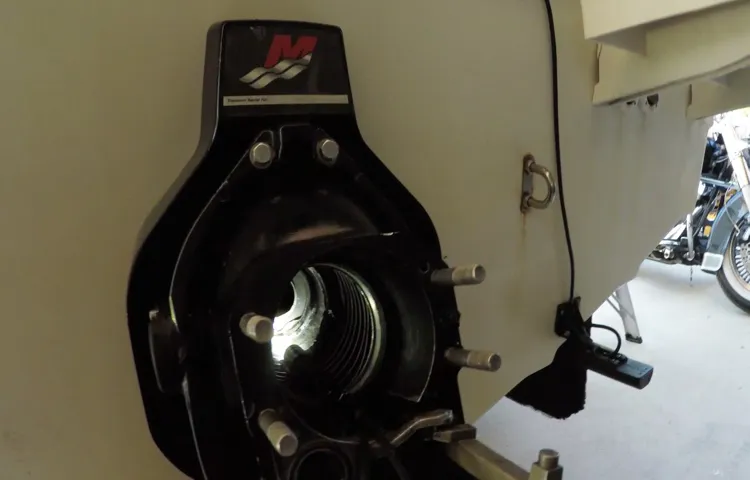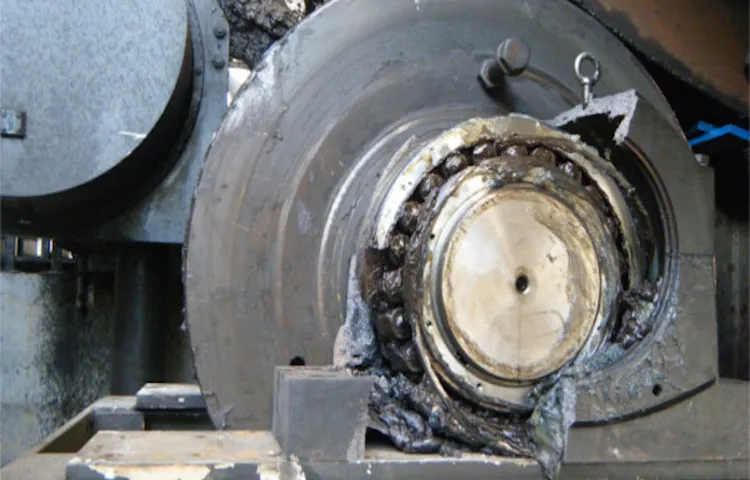As boat owners, we all know the significance of maintaining our vessels and ensuring that everything is in tip-top shape. One important component of your boat that should never be overlooked is the gimbal bearing, which plays a crucial role in your boat’s steering system. But, how often should you grease it? The answer is not as straightforward as you might think.
The frequency at which you need to grease the gimbal bearing depends on various factors, such as how often you use your boat, the type of water you frequently operate in, and the state of the bearing itself. In general, it is recommended that you grease your gimbal bearing once a year, especially if your boat is frequently exposed to saltwater. A general rule of thumb is that the more you use your boat, the more often you’ll need to grease it.
Neglecting to grease your gimbal bearing might not only impair your boat’s steering capability, but it might also damage other components like the engine. Therefore, understanding the significance of proper gimbal bearing maintenance and knowing when to grease it are essential for ensuring your boat’s longevity and performance. In this article, we’ll discuss everything you need to know about the gimbal bearing and how often you should grease it to keep your boat running smoothly.
Table of Contents
What is a Gimbal Bearing?
A gimbal bearing is a type of bearing that helps to support and stabilize the drive shaft in a boat’s stern drive unit. It works by allowing the drive shaft to rotate freely while also keeping it centered, which ensures efficient power transfer and reduces wear and tear on the unit. However, like any mechanical part, it requires regular maintenance to keep it functioning properly.
One important aspect of this is greasing the gimbal bearing. How often this needs to be done depends on a range of factors, such as the frequency of use and the conditions in which the boat operates. A general rule of thumb is to grease the gimbal bearing at least once a year, or more frequently if you notice any signs of wear or unusual noises coming from the unit.
Regular inspections and maintenance can help to ensure that the gimbal bearing remains in good condition and avoids costly repairs down the line.
Explanation of the Purpose of a Gimbal Bearing
A gimbal bearing is a crucial part of a boat’s steering system that provides flexibility and support to the boat’s bearings and shaft. It allows for the boat’s movement to be smooth and stable during turns, preventing damage to the engine or other surrounding components. The gimbal bearing serves as an intermediary between the shaft and the boat’s hull, allowing the shaft to move smoothly while accommodating the boat’s movements.
Think of the gimbal bearing as a hinge that keeps the boat’s steering system centered and supported throughout its movements. Without it, the steering system would be strained and subjected to unnecessary wear and tear, ultimately leading to expensive repairs or even engine failure. Therefore, it’s important to ensure that the gimbal bearing is properly lubricated and visually inspected for any signs of wear or damage.
Regular maintenance of the gimbal bearing and steering system will help to prolong the life of your boat and ensure a safe and enjoyable boating experience.

When to Grease a Gimbal Bearing?
If you have a boat with a sterndrive or an inboard/outboard system, you’re probably familiar with the gimbal bearing. This component allows the drive unit to pivot and move with the steering and the waves. However, like any other moving part, the gimbal bearing needs regular maintenance to function correctly.
So, how often should you grease a gimbal bearing? Typically, it’s recommended to grease the bearing every 100 hours of operation or once a year, whichever comes first. However, keep in mind that if you use your boat in saltwater or harsh conditions, you may need to grease it more often. A lack of grease can cause wear and damage to the bearing, and a failed bearing can cause serious problems, such as damage to the drive shaft or the engine.
That’s why it’s essential to follow the manufacturer’s recommendations and keep your gimbal bearing well-maintained.
Frequency Guidelines and Factors that Affect Greasing Schedule
Gimbal Bearing Greasing Schedule Maintaining a proper greasing schedule is crucial to ensure that your gimbal bearing functions at its optimal level. It is recommended to grease the gimbal bearing at least twice a year or after every 100 hours of use. However, the greasing schedule also depends on various factors such as the type of usage, type of environment, and quality of grease used.
For instance, if you use the boat in saltwater or harsh environments, it is recommended to grease the bearing more frequently to protect it from corrosion. Moreover, the quality of grease used also plays a significant role in the bearing’s performance and lifespan. Using a high-quality waterproof marine grease that is compatible with your bearing is highly recommended.
Neglecting the greasing schedule can lead to premature wear and tear of the bearing, resulting in costly repairs or replacements. So, it’s crucial to keep a regular maintenance routine to ensure the smooth functioning of your gimbal bearing for an extended period.
How to Grease a Gimbal Bearing?
When it comes to maintaining your boat, greasing the gimbal bearing is an important task that should be performed regularly. How often you need to grease the gimbal bearing largely depends on how often you use your boat and how harsh the conditions are. As a general rule, it’s recommended to grease the gimbal bearing at least once a year, but for frequent boaters, it may need to be greased more often.
Some signs that your gimbal bearing may need to be greased include squeaking or grinding noises, difficulty steering, or vibrations. When greasing the gimbal bearing, it’s essential to use marine-grade grease and to follow the manufacturer’s instructions carefully. It’s also important to inspect the gimbal bearing for any signs of wear or damage during the greasing process and to address any issues promptly.
By properly maintaining your gimbal bearing, you can ensure that your boat runs smoothly and safely on the water.
Step-by-Step Process of Greasing a Gimbal Bearing
If you want your boat’s outboard motor to last a long time, you need to take care of it. One essential maintenance task is greasing the gimbal bearing. Here’s how to do it step by step.
First, make sure your boat is out of the water and secure on a trailer or stand. Next, remove the grease gun’s nozzle and attach the fitting to the grease gun. Then, put the fitting over the grease zerk on the gimbal bearing and pump in the grease.
Keep pumping until you see the grease start to come out of the top of the bearing. That’s when you know you’ve pumped enough grease in. Finally, wipe up any excess grease and properly dispose of the used cartridges.
It’s that easy! Don’t neglect this crucial maintenance task, and you’ll enjoy many years of happy boating.
Signs of a Bad Gimbal Bearing
When it comes to maintaining your boat’s gimbal bearing, it’s essential to know how often to grease it. Generally, it’s recommended to grease it every 100 hours of operation or annually, whichever comes first. Neglecting to do so could cause irreversible damage to the bearing and compromise your boat’s steering and handling.
Signs of a bad gimbal bearing include unusual noises, such as grinding or screeching, resistance when turning the wheel, and excessive play in the steering. These symptoms can impede your ability to navigate the water safely and may even require costly repairs. Therefore, it’s crucial to keep a close eye on your boat’s gimbal bearing and address any issues promptly by greasing it regularly and hiring a professional if necessary.
By doing so, you’ll ensure optimal performance and extend the lifespan of your vessel’s steering system.
Symptoms that Indicate a Gimbal Bearing Needs to be Replaced
If you notice any strange vibrations or unusual noises coming from your boat’s stern, it may be a sign that your gimbal bearing needs to be replaced. A worn or damaged gimbal bearing can lead to a number of issues that can affect the performance of your boat, including difficulty in turning the steering wheel, reduced maneuverability, and even water leakage. To avoid these complications, it’s essential to identify the symptoms that indicate a bad gimbal bearing.
These include increased play in the engine, difficulty in turning the boat, and excessive vibration and noise. When you notice these symptoms, it’s important to have your boat inspected by a qualified technician to replace the damaged bearing with a new one. By taking this proactive step, you can ensure the safety and optimal performance of your boat out on the water.
Conclusion
In conclusion, the frequency at which you should grease your gimbal bearing depends on a variety of factors, such as usage, environment, and personal preference. Just like how some people prefer their toast lightly buttered while others like it swimming in the stuff, the amount of grease needed for your gimbal bearing will vary based on your unique situation. So, whether you choose to grease it once a year or every time you go out on the water, the most important thing is to maintain your bearing so that it can continue to spin smoothly and keep you afloat on your aquatic adventures.
Don’t let neglect sink your ship – keep that gimbal bearing greasy and keep on sailing!”
FAQs
What is a gimbal bearing and why does it need to be greased?
A gimbal bearing is a component of a boat’s steering system that allows for movement and stability. Without proper greasing, the bearing can become damaged or corroded.
How often should I grease my gimbal bearing?
It is recommended to grease your gimbal bearing at least once a year or every 100 hours of use, whichever comes first.
What type of grease should I use for my gimbal bearing?
Marine-grade grease is the most suitable for use on gimbal bearings as it can withstand exposure to water and marine environments.
How do I know if my gimbal bearing needs to be replaced?
Signs of a failing gimbal bearing include unusual noises, vibrations, and difficulty steering the boat. It is best to inspect and replace the bearing as soon as possible to avoid further damage and safety hazards.
Can I grease my gimbal bearing myself or do I need a professional?
Greasing your gimbal bearing can be done by a DIY-er, but proper knowledge and tools are necessary. It is recommended to hire a professional if you are unsure or inexperienced.
What is the cost to replace a gimbal bearing?
The cost to replace a gimbal bearing varies depending on the type of boat and other associated factors. On average, the cost ranges from $300 to $800 for parts and labor.
What are some preventative measures I can take to prolong the life of my gimbal bearing?
Regular greasing and inspection, avoiding harsh and sudden movement, and keeping the boat elevated and dry when not in use can all help to prolong the life of your gimbal bearing.


